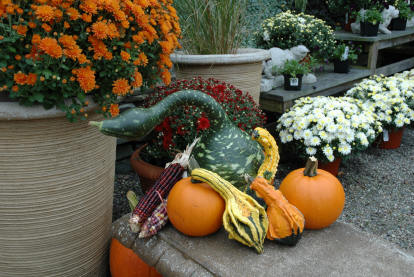
(11/7) As I was driving to work this morning, the colors caught my eye. The various yellows, reds and oranges of maples, and the bronzing of the oaks were just striking, as the sun was peering through the leaves. Autumn brings colors of a different kind. No longer do we see generous varieties of pink, purple and white from flowers, but hot colors
or red, orange and yellow from foliage as plants prepare for the winter months ahead.
This seasonal change has not only brought on a change in color in our gardens but a change in our garden chores. The summer was filled with weeding and watering. Days were too hot to begin projects, whether planting or garden construction. But now that the weather is cooler and we’ve had a bit of rain, hopefully those garden projects have begun
again.
Many plants come to life through colorful leaves and bark. Fall is the second best time to plant, so why not design a fall/winter garden? It is important to carefully choose, place and plant your trees and shrubs. The trick is to know what the effect is that you may want, design the area for an all-season garden focusing on the fall and winter, and
choose the right plant for that particular location.
 We can create these gardens with just a few good choices of plants that will thrive in our climate. When thinking about designing a fall and winter garden, think about texture and form. Unless you choose an evergreen shrub, leaves will be leaving us this time of year. So bark,
color and form become a high importance.
We can create these gardens with just a few good choices of plants that will thrive in our climate. When thinking about designing a fall and winter garden, think about texture and form. Unless you choose an evergreen shrub, leaves will be leaving us this time of year. So bark,
color and form become a high importance.
Visit nurseries and garden centers and check out what is available. Many trees, like sweetgum, sourwood, red maples and serviceberry offer wonderful color in the fall. Shrubs, like oakleaf hydrangea and fothergilla are also beautiful during the fall and winter months.
Many shrubs offer beautiful berries, like red chokeberry, inkberry holly and callicarpa that may hold their fruit through the winter, before the birds discover them. Consider mixing plants that have fall and winter interest with the plants that you enjoy in the spring and summer. Here is a short list some plants you may want to try.
Hydrangea quercifolia, oakleaf hydrangea, is a large shrub that not only has summer interest with its big, white conical flowers, but also has terrific red to purple fall color. The bark on the shrub is a cinnamon color and peeling. A native shrub, it is grown best in part shade. This plant will be generous with its fall color. Typically reaching a
height and spread of 6-8 feet, site this plant in a shrub border or as a specimen plant. Dwarf cultivars are available as well.
Fothergilla gardenii is a great native small to medium sized shrub reaching 4 -6 feet in height as well as spread. It’s not only showy in the spring with its white, bottle-brush flowers, but the yellow, orange, and red fall colors are spectacular. This plant is a slow grower, making it a good choice for foundation plantings. It does prefer an
acidic soil with good drainage and part sun to full sun.
Aronia arbutifolia, red chokeberry, has proven to be another spectacular native plant for fall and winter interest. You can enjoy this plants bright red fruit from September through January as well as its red fall color in October. It tolerates most soil types excluding dry, but does prefer well drained soils. It will reach 5-6 feet and is a good
selection for the shrub border.
Callicarpa japonica, beautyberry, is a shrub that will stretch 4 to 6 feet in height. It likes full sun to part shade and gets lovely purple berries in the fall - hence the fall attraction of this shrub, as purple is not a common color this time of year. Use this plant for a shrub border, or mix it in with some spring blooming plants. The stems
with berries are great for indoor arrangements.
Its native cousin is Callicarpa americana is easy to grow, and slightly faster. Having the same requirements as its Asian cousin, this native can be a bit more difficult to find in the industry, but certainly worth the time to look.
Lindera bezoin, spicebush, shows a great yellow fall color. This plant is known for its fragrant stems when broken. However, the yellow color mixes wonderfully with the oranges and reds of the fall palette. It likes part shade to full sun, but becomes more open and wild the more shade you provide it. It is a large shrub, potentially reaching 8
feet, making it a good native plant for the shrub border.
Liquidambar styraciflua, sweetgum, is a large native shade tree reaching 60-75 feet in height. The beautiful tree offers tons of fall color - colors ranging from yellow, orange, red and purple. It wants full sun and will grow well in most soil types. The star-shaped leaves give this tree an interesting texture through the summer months. The biggest
downfall of this stately tree is its seeds. It will drop seed balls, causing some lawn mowing folks to dislike this tree.
Nyssa sylvatica, or blackgum, is a tree often overlooked. This native tree has a habit very similar to the pin oak. The canopy is pyramidal in shape, like the pin oak, but the leaves are oval. The fall color is one of the best of our native trees, changing from dark green in the summer to a brilliant scarlet in the fall. It will stretch to 30 - 40
feet, but is slow growing, making it a good street tree and nice large specimen tree.
River birch, Betula nigra, a native tree to river and creek banks as well as marshy areas, has interesting bark. The cinnamon colored peeling bark is exciting in all four seasons. The leaves on this tree are small, and the canopy is not dense, allowing the bark to be visible in and out of leaf. This tree will reach 50 feet. It thrives in moist
soils, but lucky for us, it is very versatile, adapting to drier locations as well. In a grouping of three or five, this selection is outstanding. Use it as a plant grouping in the yard, or as a single specimen tree. Grown in clumps or single stemmed allows for a variety of design styles, from a more natural look to a formal appearance.
The paperbark maple, Acer griseum, is one of my favorite trees. This slow-growing tree offers a cinnamon colored, peeling bark on the trunk and branches. It is a slow grower that likes part shade to full sun and reaches about 20-25 feet. It’s not fussy about soil, but don't place it in a really dry location. Well drained soils are best. This is a
great selection for a specimen tree or focal point in the garden where the tree bark and color will be visited on a more personal level.
In addition to planting shrubs and trees, there is still time to plant bulbs for spring color. Bulbs are sold almost everywhere, from grocery stores to garden centers. Tulips, daffodils, grape hyacinths are just a few colorful possibilities. If you live in a deer populated area, just be sure to check if the bulbs you are planting will be devoured
by the wildlife. Deer love tulips, but daffodils are left alone.
We’ve had a few frosts, so hopefully you have either covered the tropical plants or brought them in for the winter. Check the plants for insects and spray with an insecticidal soap for houseplants prior to bringing them into the house.
Enjoy the last bit of the gardening season before the holidays monopolize your time!
Read other fall related gardening articles
Read other articles by Mary Ann Ryan